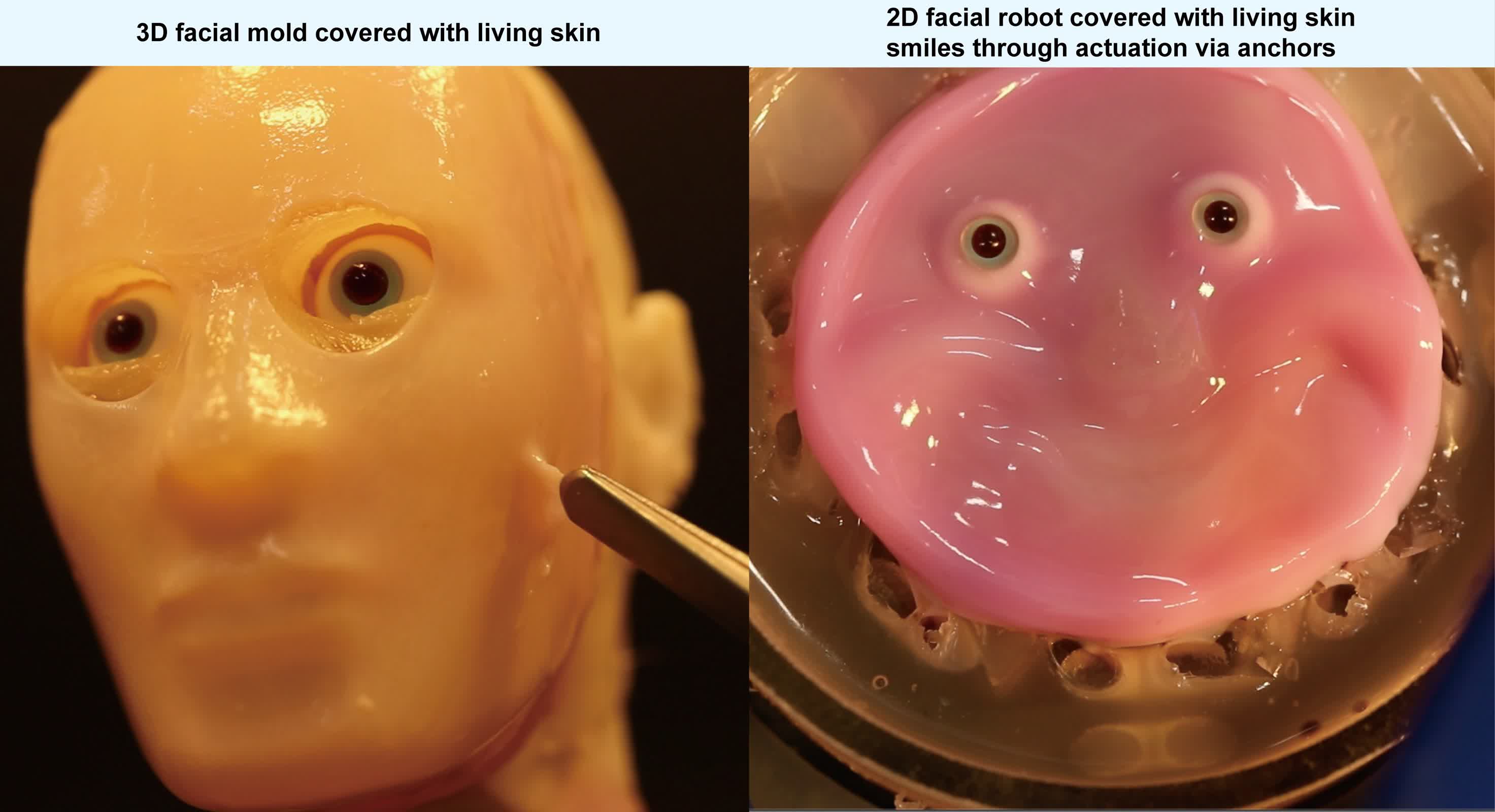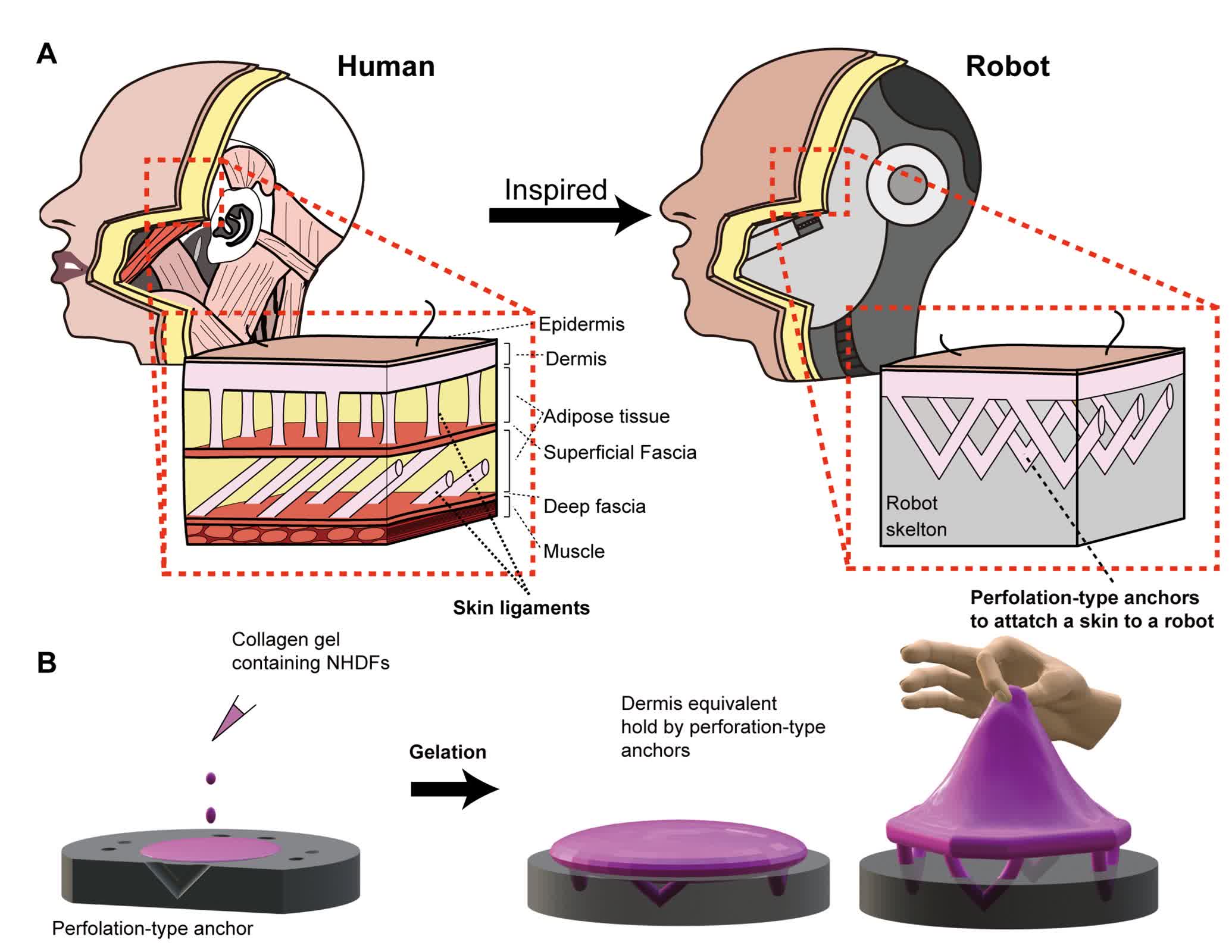WTF?! Scientists at the University of Tokyo have developed a way to apply skin engineered from biological cells onto a robot's face and keep it adhered to the surface as it "smiles." This could be a breakthrough for medical and cosmetic research, as similar developments have already shown. Moreover, realistic-looking smiling robots could one day become more accepted in the workplace and social situations.
Researchers at the University of Tokyo have found a way to bind engineered skin tissue made of biological cells to humanoid robots to make them appear more lifelike. The team, led by Professor Shoji Takeuchi, took their inspiration from human skin ligaments, and used special perforations in a robot face to help a layer of skin take hold.
The team attached their living skin layers to a 3D facial model of a human and a small, 2D "face" with robotic actuators. Not only did the skin adhere, but it also withstood manipulation using the actuators, which formed a rudimentary, smiling face.
"By mimicking human skin-ligament structures and by using specially made V-shaped perforations in solid materials, we found a way to bind skin to complex structures. The natural flexibility of the skin and the strong method of adhesion mean the skin can move with the mechanical components of the robot without tearing or peeling away," Takeuchi said.
Mini anchors or hooks have previously been used to attach skin tissue to solid surfaces, but these methods limited the types of surfaces that could receive skin coatings and could cause damage during motion. By engineering small perforations instead, essentially any shape of surface can have skin applied to it. The breakthrough for the team was their development of a special collagen gel for adhesion, but because it is naturally viscous, it is difficult to feed into the minuscule perforations. The team turned to a common technique for plastic adhesion called plasma treatment, managing to coax the collagen into the fine structures of the perforations while also holding the skin close to the surface.
"Manipulating soft, wet biological tissues during the development process is much harder than people outside the field might think. For instance, if sterility is not maintained, bacteria can enter and the tissue will die," said Takeuchi. "However, now that we can do this, living skin can bring a range of new abilities to robots."
One such ability is self-healing, which Takeuchi says is a big deal. Some chemical-based materials can be made to heal themselves, but they require triggers such as heat, pressure or other signals, and they also do not proliferate like cells. "Biological skin repairs minor lacerations as ours does, and nerves and other skin organs can be added for use in sensing and so on," he said.
Not that anyone could be fooled into thinking a robot covered with this engineered skin tissue is an actual human, although Takeuchi is already working towards this goal – or at least a close approximation of it. His team identified new challenges from this initial research including the necessity for surface wrinkles and a thicker epidermis to achieve a more human-like appearance. "We believe that creating a thicker and more realistic skin can be achieved by incorporating sweat glands, sebaceous glands, pores, blood vessels, fat and nerves," he said. Also, if sensors can be embedded, robots could have better environmental awareness and improved interactive capabilities.
The team noted that it would take many years of testing before it is used commercially.
This research will more likely be first leveraged in the cosmetics industry and to help train plastic surgeons. The idea of an organ-on-a-chip is not new, and has been useful for drug development, but something like a face-on-a-chip could be used in research for skin aging, cosmetics and surgical procedures. It could, for example, provide a more realistic platform for testing new skincare products, eliminating or reducing need for animal testing. Also, it is conceivable that the ability to grow and attach living skin could one day be applied to treating severe burns or creating more effective skin grafts.
Similar developments also illustrate how useful engineered skin on robots could be for medical research. In research funded by the National Science Foundation and the National Institutes of Health, scientists have created innovative soft robots equipped with electronic skins and artificial muscles that allow them to sense their surroundings and adapt their movements in real-time, according to a paper published in Nature Communications.
"These soft robots can perform a variety of well-controlled movements, including bending, expanding and twisting inside biological environments," said Lin Zhang, first author of the paper and a postdoctoral fellow in the Department of Applied Physical Sciences. They can change shape to fit organs for better sensing and treatment and are capable of continuous monitoring of internal conditions, like bladder volume and blood pressure. They can also provide treatments, such as electrical stimulation, based on real-time data, and can be swallowed to monitor and treat conditions in the stomach.
Further down the road, more realistic-looking robots that can display facial expressions such as smiles could be used to better integrate them into social and work situations.
Takeuchi is a pioneer in the field of biohybrid robotics. His lab has created mini robots that walk using biological muscle tissue, 3D printed lab-grown meat, and engineered skin that can heal.
Takeuchi's study appeared in the journal Cell Reports Physical Science.

